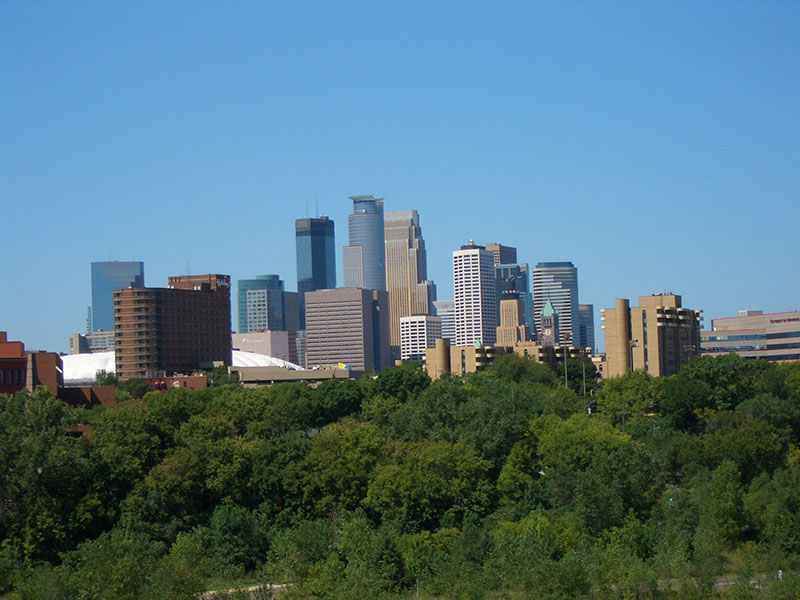

The Wickman lab is located on the East Bank/Twin Cities campus of the University of Minnesota, home to the Academic Health Center and most of the biomedical research labs and associated facilities in the University of Minnesota system. The local concentration of research expertise and energy creates a stimulating scientific environment – an ideal place to begin or continue training toward a career in the life sciences. In addition, the Minneapolis-St. Paul metro area has much to offer anyone of any age or stage of life.
Minneapolis - St. Paul
The “Twin Cities” of Minneapolis and St. Paul, and surrounding communities, compose the Twin Cities metropolitan area, which is home to more than 3 million residents. The Twin Cities metropolitan area is the 16th largest in the United States, and it ranks among the most desirable places to live. Whether you like nightlife, museums, theater, music, or sports, there are opportunities to enjoy this community year-round. And, if you enjoy the outdoors and the opportunities a 4-season climate affords, you will appreciate the well-developed park and trail system, which connects local neighborhoods with the Mississippi River, area lakes, and numerous green areas. These trails and parks are open year-round to accommodate runners, bikers, and skiers. The Twin Cities area is quite popular among bikers, with more than 40 miles of on-street bike lanes and 82 miles of off-street bike trails in Minneapolis alone! There is also extensive off-street recreational biking available throughout the metro area and state. The Twin Cities metropolitan area also has an extensive bus system; more than 35 direct routes serve the University of Minnesota (students and employees get a fare discount). In addition, an expanding light rail system connects the downtowns of Minneapolis and St. Paul runs and runs directly through the University of Minnesota campus, while also providing a convenient and economic way to get to the Minneapolis-St. Paul International Airport, one of the largest airports in the United States and hub for Delta Airlines. Collectively, these features make the Twin Cities metropolitan area a fun, healthy, and comfortable place to live, regardless of your stage in life. Learn more about this fantastic place to live!
University of Minnesota
The University of Minnesota was established in 1851 and is Minnesota’s flagship university. The Twin Cities campus serves over 32,000 undergraduate students and 16,000 graduate/professional students. The campus is also home to more than 4,000 faculty, including several members of the National Academy of Sciences, the National Academy of Engineering, the Institute of Medicine, and the American Academy of Arts and Sciences. Current and former faculty members have won Guggenheim Fellowships, MacArthur Fellowships (“genius grants”), and Nobel Prizes. Notable alumni include former Vice President Walter Mondale and Super Bowl championship coach Tony Dungy. The Academic Health Center (AHC) is the gateway to biomedical research at the University of Minnesota. The AHC consists of the Medical School, School of Dentistry, School of Nursing, College of Pharmacy, School of Public Health, and the College of Veterinary Medicine, and is home to over 1500 faculty and 6000 students. Research within the AHC is supported by approximately $400 million in sponsored research grants and is facilitated by an array of institutional core facilities that make state-of-the-art equipment, techniques, and expertise readily available to interested scientists.
Department of Pharmacology
The Department of Pharmacology is 1 of 6 basic science departments within the Medical School and is home to 20 primary faculty members, a strong graduate program, and a minor program for undergraduate students. The main departmental office is located on 6th floor Jackson Hall, located on the Minneapolis (East Bank) Campus of the University of Minnesota; administrative assistants are available in the office to assist with human resources issues and grant/fellowship preparation. Most research labs for primary faculty members are found on the 2nd and 3rd floors of Nils Hasselmo Hall (NHH), located just across the street from Jackson Hall. The 2nd and 3rd floors of NHH contain shared departmental resources including an array of centrifuges, an Odyssey® phosphorimager, NanoDrop 2000 spectrophotometers, SpectraMax i3 multi-mode plate reader, myECL DNA/protein gel documentation systems, Applied Biosystems® StepOnePlusTM real-time PCR systems, autoclaves, ice machines, spare freezers, and Millipore water purification systems. Check out the recent Department of Pharmacology newsletter to learn more about our research, trainees, alumni, programs, and outreach.
Viral Vector and Cloning Core Integrative Biology and Physiology Phenotyping core University Imaging Centers
Mouse Behavioral Core University of Minnesota Genomics Center Center for Mass Spectrometry and Proteomics

